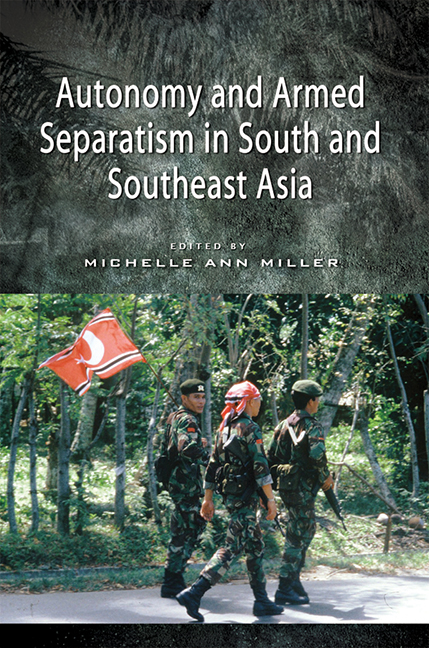Book contents
- Frontmatter
- Dedication
- Contents
- Acknowledgements
- About the Contributors
- 1 The Problem of Armed Separatism: Is Autonomy the Answer?
- 2 Mediated Constitutionality as a Solution to Separatism
- 3 Self-Governance as a Framework for Conflict Resolution in Aceh
- 4 Autonomy and Armed Separatism in Papua: Why the Cendrawasih Continues to Fear the Garuda
- 5 The Parallels and the Paradox of Timor-Leste and Western Sahara
- 6 Between Violence and Negotiation: Rethinking the Indonesian Occupation and the East Timorese Resistance
- 7 Struggle over Space in Myanmar: Expanding State Territoriality after the Kachin Ceasefire
- 8 Sri Lanka's Ethnic Conflict: The Autonomy-Separation Dialectic
- 9 Unitarianism, Separatism and Federalism: Competing Goals and Problems of Compromise in Sri Lanka
- 10 Autonomy and Armed Separatism in Jammu and Kashmir
- 11 Armed Conflicts and Movements for Autonomy in India's Northeast
- 12 Southern Thailand: The Trouble with Autonomy
- 13 The Last Holdout of an Integrated State: A Century of Resistance to State Penetration in Southern Thailand
- 14 Interlocking Autonomy: Manila and Muslim Mindanao
- 15 History, Demography and Factionalism: Obstacles to Conflict Resolution through Autonomy in the Southern Philippines
- 16 Conclusion
- Index
11 - Armed Conflicts and Movements for Autonomy in India's Northeast
Published online by Cambridge University Press: 21 October 2015
- Frontmatter
- Dedication
- Contents
- Acknowledgements
- About the Contributors
- 1 The Problem of Armed Separatism: Is Autonomy the Answer?
- 2 Mediated Constitutionality as a Solution to Separatism
- 3 Self-Governance as a Framework for Conflict Resolution in Aceh
- 4 Autonomy and Armed Separatism in Papua: Why the Cendrawasih Continues to Fear the Garuda
- 5 The Parallels and the Paradox of Timor-Leste and Western Sahara
- 6 Between Violence and Negotiation: Rethinking the Indonesian Occupation and the East Timorese Resistance
- 7 Struggle over Space in Myanmar: Expanding State Territoriality after the Kachin Ceasefire
- 8 Sri Lanka's Ethnic Conflict: The Autonomy-Separation Dialectic
- 9 Unitarianism, Separatism and Federalism: Competing Goals and Problems of Compromise in Sri Lanka
- 10 Autonomy and Armed Separatism in Jammu and Kashmir
- 11 Armed Conflicts and Movements for Autonomy in India's Northeast
- 12 Southern Thailand: The Trouble with Autonomy
- 13 The Last Holdout of an Integrated State: A Century of Resistance to State Penetration in Southern Thailand
- 14 Interlocking Autonomy: Manila and Muslim Mindanao
- 15 History, Demography and Factionalism: Obstacles to Conflict Resolution through Autonomy in the Southern Philippines
- 16 Conclusion
- Index
Summary
The little known North East region of India, which comprises seven federal units (referred to hereafter as “states”) and connects to the Indian mainland by a narrow 22 kilometre land corridor, has been a theatre of prolonged armed conflicts. Beginning with India's independence in 1947, several armed insurgent movements have emerged in each of these states with wide ranging demands. While some of the insurgencies have demanded outright secession from India, others have asked for greater self-governing rights, still others insist on the partitioning of existing states into new administrative units as also on various forms of autonomy to preserve their unique identity and gain greater control over their lives and resources. Most of these insurgencies, exploiting the prevalent alienation and grievances among the people against what they refer to as an “apathetic and distant” New Delhi, have spanned over decades without being resolved. Each of these insurgencies has also been accompanied by lesser known non-armed movements by ethnic groups, clamouring for greater administrative powers. These multiple movements have generated a specter of instability in the region, which has continued irrespective of the government's limited success at establishing peace and improving governance through the existing provisions for autonomy under the Indian constitution.
OFFICIAL APPROACH TOWARDS THE “EXCLUDED NORTHEAST”
The British, during their rule in India, annexed the Assam plains in 1826. It was the beginning of a process of domination over the North Eastern region, which culminated in the control over the Mizo Hills in 1890. All these areas formed parts of Assam Province of British India. Under the Government of India Act, 1935, the hill areas of Assam were divided into two categories — “excluded” and “partially excluded areas”. Areas such as Lushai Hills (now Mizoram), the Naga Hills (now Nagaland) and the North Cachar Hills (now part of Assam) were declared as “excluded areas”. No federal or provincial legislation extended to the districts automatically. Areas such as the Khasi and Jaintia Hills, the Garo Hills (now all part of the state of Meghalaya), and the Mikir Hills (in Assam) were declared as “partially excluded areas”. These areas were administered by the state government subject to the special powers of the Governor. In effect, the 1935 Constitution did not accord local self government or political autonomy to the hill tribes of the excluded and partially excluded areas to manage their local affairs”.
- Type
- Chapter
- Information
- Autonomy and Armed Separatism in South and Southeast Asia , pp. 196 - 216Publisher: ISEAS–Yusof Ishak InstitutePrint publication year: 2012



